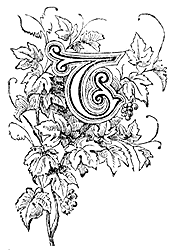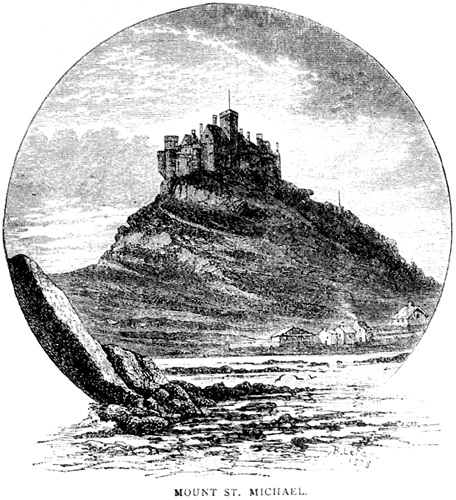 |

HIS most picturesque and romantic Mount lies off the south coast of Cornwall, opposite to the little market town of Alarazion, or Market-Jew - the name referring probably to its ancient Jewish inhabitants; in fact, some of the old smelting houses in its vicinity are still called Jews' Houses.
Alarazion is delightfully situated on the inner shore of Mount's Bay, and has a mignificent prospect before it, a wide and glorious expanse of waters; to the westward the Rundlestone, to the east the Lizard's Point, and in front St. Michael's, " the Guarded Mount," a towering peak of greenstone. It was, as legendary lore tells us, a part of Lyonness in the days of King Arthur; a vast forest - then six miles distant from the sea - environed it, and it was the haunt of wild beasts. Here Arthur, fought one of his many battles.
 The Cornish name for the Mount is in accordance with the legend that it once stood inland in a forest, for they call it "Caraclowse in Cowse," i.e. - "The Grey Rock in the Wood." The inroad of the sea that insulated the Mount took place, according to the Saxon Chronicle, in 1099. The Cornish name for the Mount is in accordance with the legend that it once stood inland in a forest, for they call it "Caraclowse in Cowse," i.e. - "The Grey Rock in the Wood." The inroad of the sea that insulated the Mount took place, according to the Saxon Chronicle, in 1099.
St. Michael's Mount had early a sacred character, for it was said that here St. Michael himself had appeared to a holy anchorite who dwelt upon it, and so sacred was it hence esteemed that St. Keyne made a pilgrimage to it in 490.
The Mount does not look as high as it really is, because the vast expanse of sea round it diminishes its apparent size.
It is, however, 231 feet above the level of the sea, exclusive of the buildings on its summit. It is reached from Marazion at low water by a paved causeway 1,200 feet long; but at high water the rock is insu lated. It is a mile round; on the right is a pile of greenstone on clay slate called the Chapel Rock.
A little fishing village lies at the foot of the Mount, with a harbour of sufficient depth of water for vessels of 500 tons; above it towers precipitously the great grey rock. The ascent was commanded by a cross-wall pierced with embrasures, and by a platform having two small batteries.
The castle must have been a strong building.
At present the monastic remains are occupied as a country seat by the proprietor of the Mount, Lord St. Levan; it is a delightful summer residence. The diningroom was the refectory of the monastery, and contains a curiously carved frieze of hunting subjects; it is called by the people the Chevy Chase room.
At one of the angles of the tower on the Mount is to be seen the stone lantern in which, during the fishing season, or in tempestuous weather, the monks kept a light to guide seamen. This lantern is vulgarly called St. Michael's Chair. "Only one person can sit in it, and the attempt is not without danger, for the chair, elevated above the battlements, projects so far over the precipice, that the climber must actually turn the whole body at that altitude in order to take a seat in it." The superstition is that if a married woman sits in it before her husband has done so, she will rule him; if the husband enters it first "the awful rule and right supremacy" of his position will be his.
The monks who in early time occupied the Mount were Benedictines. Some time after the Conquest the Gilbertines took their place, and their cell was attached by Robert Earl of Cornwall to the Abbey of St. Michael, on Mont St. Michel, off the coast of Normandy; for both France and England possess a St. Michael's Mount.
While Richard Coeur de Lion was in captivity in Austria, Hugh de la Pomeroy, an adherent of John's, seized the Mount, expelled the monks, and fortified the place for that rebellious prince. On the return of Richard, however, Pomeroy, dreading his vengeance, fled to his castle of Berry Pomeroy, and some say had himself bled to death, others, that mounting his favourite charger, he leapt from the edge of the rocks at Berry Pomeroy, and was thus killed.
Shortly after the lost battle of Barnet, John, Earl of Oxford, a Lancastrian noble, sailed hither, disguised himself and some of his followers as pilgrims, gained an entrance to the castle (which belonged to Canterbury at that time), overpowered the garrison, and held the stronghold for Henry VI. The Yorkists besieged the Mount for several months ineffectually, and Oxford, when he surrendered, obtained honourable terms of capitulation and a full pardon.
Perkin Warbeck possessed the castle for a time, and left his beautiful wife, "the White Rose of Scotland," here for safety; but she was taken from it by Lord Daubeny, and carried to Henry VIL's court. He treated her with marked respect, and gave her a place about the queen.
Upon the suppression of the monastery, St. Michael's Mount was given to Humph-rey Arundell of Lanherne, but as lie placed himself at the head of the Cornish insurrection in 1549, it was taken from him as the forfeiture of treason, and he was beheaded. He had obstinately contested the possession of the Mount with the royal forces.
In Charles I.'s civil war, the fortress was held for the king by Sir Francis Bassett, who was, however, compelled to surrender to the Parliamentarians in 1646.
Charles II. visited the Mount; and in 1846 Queen Victoria and the Prince Consort honoured it with their presence. The print of the Queen's foot on the pier is marked by an inlaid brass.
|
 |